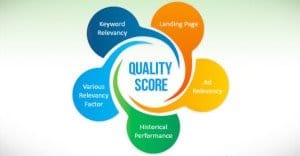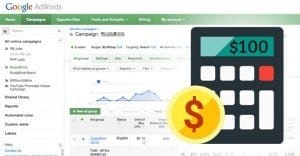3 Tricks to Get Cheap Clicks with Google AdWords

When it comes to Google AdWords – and other PPC options, like the upcoming Facebook Atlas – it’s all about efficiency. You can’t go for keywords that have too low volume; even if the payout is high, one click per month isn’t going to get you anywhere. On the other hand, you can’t go for keywords with extremely high volumes; the cost per click would be outrageous, making it impossible to turn a profit. You need to strike the right balance between cost per click and search volume. Here are three ways you can exploit to find keywords in that balance.
1. Pick the Right Keyword Match Type
Match type is a specification you can make within your ad groups for your keywords, and there are three possible options. Picking the right one for your keyword choice is imperative.
Method 1: Broad Match. Broad match keywords are matches for any query whatsoever that includes your keywords in any way, shape or form. The results will be very broad and may not necessarily attract the right kind of traffic. For example, if your keyword was “Targus Backpacks,” all of the following queries would bring up your ad:
- “Where to buy Targus backpacks”
- “Targus Black Backpacks”
- “Why do Targus Backpacks suck?”
- “What are the best backpacks from Targus?”
As you can see, a wide variety of queries can fit a broad match. They all use the word Targus and the word backpacks, and that’s all the similarity they have. If you’re trying to sell a Targus backpack, only a couple of those queries would count your site among relevant results.
Method 2: Phrase Match. The phrase match is a narrower match form than the broad match. The keyword phrase you use needs to show up in the exact order as it’s presented, but can be surrounded by other words. In the Targus backpacks example, the first and third example queries are phrase match queries; they include “Targus backpacks” with nothing breaking up the phrase.
Method 3: Exact Match. This is the most narrow option, restricting your search results to only what matches your phrase, no more, no less. If your phrase is “Targus backpacks,” that’s the only phrase that will trigger your ad. Example query #1, because it has words before the keyword phrase, does not count.
How do you determine which match type to use for what query? Consider the results. A broad match will get the most impressions, but won’t reach the right audience as often as the other types of matches. On the other hand, the exact match may be too precise; a keyword may have a good potential volume as a phrase match but too low a volume as an exact match.
Typically, it’s a good idea to start with the exact match and expand upwards as needed. If you find exact matching to be too narrow, open the keyword up to phrase matching. If that’s still unsatisfactory, broad match might work. If that proves too unfocused to be profitable, you need to find a new keyword.
2. Use Negative Keywords
For some people, the phrase “negative keywords” brings to mind ideas of nefarious SEO practices and negative SEO attacks. This is an incorrect impression. Negative keywords are an AdWords function that can be extremely beneficial to your broad and phrase matched keywords.
Going back to the backpacks example, notice that the third query has a question; why do Targus backpacks suck? You probably don’t want to serve your ad selling backpacks to the people looking up that information, so you might add “suck” to your negative keyword list. This prevents your ad from showing up for queries involving the word.
You can and should use a wide variety of negative keywords, which come in two basic varieties.
Variety 1: General. General negative keywords are words like “suck” in this context. They’re keywords that apply to just about any query, turning the query into a detrimental question. You can find several good lists of possible general keywords to block out, in order to avoid the worst spam and the people who wouldn’t be interested in your products.
Variety 2: Keyword Specific. These are the negative keywords that only apply to your specific situation. Say you sell Targus backpacks, but you don’t have any black backpacks whatsoever. It’s an inexplicable gap in your inventory. Rather than advertise for anyone looking for black backpacks, drawing them in only to discover you don’t have what they want, you could add “black” to your negative keyword list.
3. Inch Your Bids Lower
As you use AdWords, Google begins to compile a quality score that attaches to your account. Each time you post an ad, Google ranks that ad. They also rank your landing page, so make sure it’s not a spam page. That’s just general good advice.
As you build a higher quality score, you can reap certain rewards that come from playing by the rules and providing high quality ads to Google users. One of those benefits is the ability to pull rank and place in a higher position for ads at a lower bid. Unless your keyword has fierce competition, once you have established a higher quality score, your competition tends to back off.
When this happens, Google should ideally begin to inch down your bid. Unfortunately, this doesn’t always happen. At this point, what you should do is start to lower your bid by a small amount each time you renew it. As long as you don’t reach a crossover point where you’re paying less than your strongest competition, you’ll be able to slowly drive down the price.
The higher your overall quality score, the more you will be able to push down your bid. A higher quality score will help keep your ad positioned high on the list, while allowing you to pay less for that position.
The one thing you need to watch while you lower your bid is your volume. If your volume begins to suffer, so does your income from your ads. Saving a few cents per click isn’t worth the profit hit when your volume drops suddenly.
 ContentPowered.com
ContentPowered.com







I am a new small business advertiser on a limited budget. When I use Adwords’ display planner, I put in a daily budget of $25 and the topic with the highest relevancy score (10/10) to my website is Women’s Apparel, and the max traffic/per cent max bid in my budget range using the forecast tool comes out to a max bid of $0.02. My question is, how do I interpret this? I know apparel is a very competitive and heavily advertised marketplace- are my ads really going to show up if I choose this topic and put in my max daily budget of $25 and max bid of 0.02? The forecast planner says I can get 13k clicks/week with these parameters, which at my modest budget would be huge, but I am wondering how true this is? How can I really expect my ads to show often enough against advertisers putting hundreds of dollars in a day that I gain 13k clicks from spending $125 a week? Surely my ads would not even rank even if my quality score was good at this price point? Would I be better off choosing less popular topics even though the cost is higher for fewer clicks (again according to the forecast tool)? Thanks so much for your help!
Thanks for the info